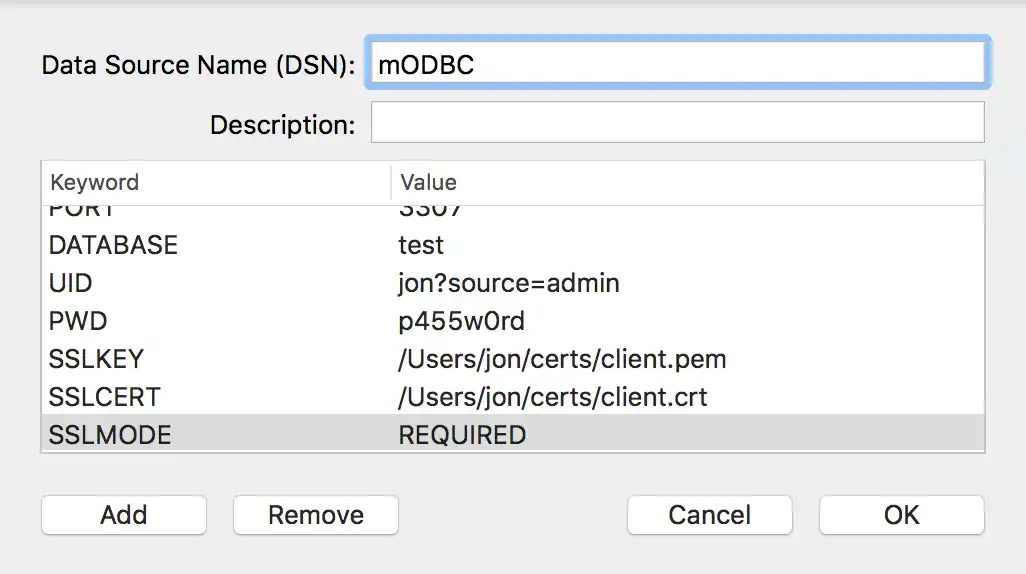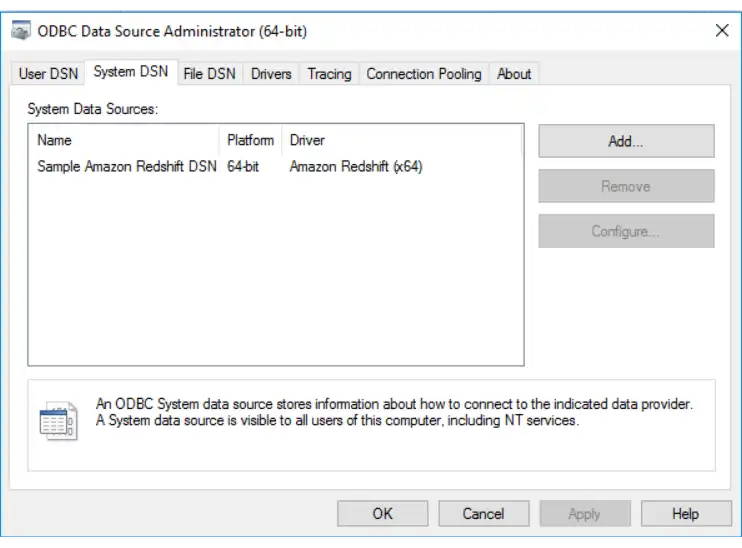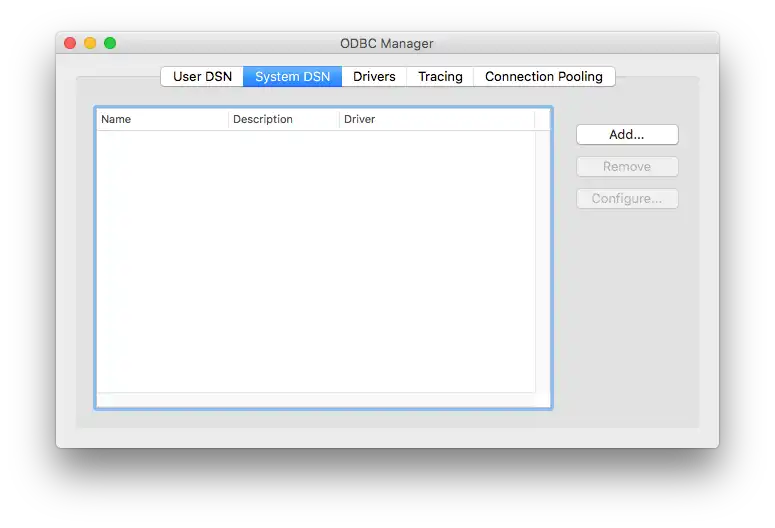Connect from Tableau Desktop with Authentication and TLS/SSL
On this page
Prerequisites
Connecting Tableau to the MongoDB Connector for BI requires the following:
Connecting Tableau to the MongoDB Connector for BI requires the following:
Procedure
The connect Tableau to the MongoDB Connector for BI using TLS/SSL:
Download and install the MongoDB BI Connector ODBC Driver.
Download the MongoDB BI Connector ODBC Driver and run the Windows installer (.msi).
Create a system DSN.
To securely connect Tableau to the BI Connector, a system DSN configured to use the MongoDB BI Connector ODBC Driver is required. To create a system DSN, follow the steps below:
Select a MongoDB BI Connector ODBC Driver from the list of available drivers.
Select either the MongoDB ODBC ANSI Driver or the MongoDB ODBC Unicode Driver, then click OK.
Note
The ANSI ODBC driver offers maximum performance but has a limited character set. The Unicode ODBC driver supports a wider character set but may be slightly less performant as a result.
Fill in the necessary form fields.
Click the Details button to expose the lower half of the form.
The following form fields are required:
Field Name | Description |
|---|---|
Data Source Name | A name of your choice. |
TCP/IP Server | Address of the server where your
mongosqld process is running. If you have enabled
BI Connector on MongoDB Atlas, you can find the
hostname of the server where mongosqld is running
in the connection information
for your cluster. |
Port | Port number of your mongosqld
process. |
Database | The name of the database to connect to, e.g. test. |
Provide connection information.
The following fields are required when running with
--auth enabled or when connecting to an
BI Connector for Atlas instance.
Field Name | Description | |||||||||
|---|---|---|---|---|---|---|---|---|---|---|
User | Username of the MongoDB user who is authenticated to use your target database. You can specify the following authentication options after your username as URI-style query parameters:
ExampleTo authenticate as user ExampleTo authenticate as user ExampleTo authenticate as user For more information about Kerberos configuration, see Configure Kerberos for BI Connector. | |||||||||
Password | The authenticated user's password. NoteYou can't use curly braces ( | |||||||||
Authentication | The default authentication method. When using the MongoDB BI Connector ODBC Driver, this field is not required. To use the authentication plugin in conjunction with
another ODBC driver, fill in this field with the
string |
Fill in the SSL form fields.
Access the TLS/SSL form fields by clicking Details >>, then the SSL tab. The following parameters are available and may be required, depending on your TLS/SSL configuration:
Field Name | Description |
|---|---|
SSL Key | The location of the client/server key file. |
SSL Cert | The location of the client/server certificate file. |
SSL CA File | The location of the file containing a list of trusted
certificate authorities. |
SSL Cipher | The location of the file containing a list of permitted
ciphers. |
SSL Mode | Set to REQUIRED to require an encrypted channel. If an
encyrpted channel is not provided, the connection fails. |
RSA Public Key | The location of the PEM file that contains the RSA public key. |
Note
The BI Connector for Atlas uses TLS/SSL but does not require any TLS/SSL settings to be configured in your system DSN.
Download and install the MongoDB BI Connector ODBC Driver.
Download the MongoDB BI Connector ODBC Driver and run the macOS installer (.dmg).
Create a system DSN.
To securely connect Tableau to the BI Connector, a system DSN configured to use the MongoDB BI Connector ODBC Driver is required. To create a system DSN, follow the steps below:
Launch ODBC Manager.
Note
ODBC Manager is included with the MongoDB BI Connector ODBC Driver.
Important
The 1.0.16 edition of ODBC Manager included with the MongoDB BI Connector ODBC Driver is not compatible with macOS Catalina or later versions of macOS. If you are on Catalina or a later version of macOS, download and install the latest version (1.0.19) of ODBC manager.
Select a MongoDB BI Connector ODBC Driver from the list of available drivers.
Select either the MongoDB ANSI ODBC driver or the MongoDB Unicode ODBC driver, then click OK.
Note
The ANSI ODBC driver offers maximum performance but has a limited character set. The Unicode ODBC driver supports a wider character set but may be slightly less performant as a result.
Add the necessary keywords.
Add a keyword value pair by clicking the Add button.
Modify the Keyword by double-clicking on it, entering the desired keyword, then pressing enter.
Modify the Value by double-clicking on it, entering the desired keyword, then pressing enter.
Using the procedure above, add the following keywords:
Keyword | Value |
|---|---|
SERVER | The hostname or IP address of the MongoDB Connector for BI host. ImportantUse |
PORT | |
DATABASE | The database to use after connecting. NoteRequired when connecting with Microsoft Excel. |
For the complete list of ODBC parameters, see Connector/ODBC Connection Parameters.
For example, your user DSN configuration should look similar to the following:

Note
Do not close the setup window. Proceed to the next step.
Add the authentication keywords.
Add a keyword value pair by clicking the Add button.
Modify the Keyword by double-clicking on it, entering the desired keyword, then pressing enter.
Modify the Value by double-clicking on it, entering the desired keyword, then pressing enter.
Using the procedure above, add the following keywords:
Keyword | Value | |||||||||
|---|---|---|---|---|---|---|---|---|---|---|
UID | The username for the user that can access the active MongoDB Connector for BI database. You can specify the following authentication options after your username as URI-style query parameters:
ExampleTo authenticate as user ExampleTo authenticate as user ExampleTo authenticate as user For more information about Kerberos configuration, see Configure Kerberos for BI Connector. | |||||||||
PWD | The password associated with the UID. NoteYou can't use curly braces ( |
For the complete list of ODBC parameters, see Connector/ODBC Connection Parameters.
For example, your user DSN configuration should look similar to the following:

Add the SSL keywords.
Add a keyword value pair by clicking the Add button.
Modify the Keyword by double-clicking on it, entering the desired keyword, then pressing enter.
Modify the Value by double-clicking on it, entering the desired keyword, then pressing enter.
Note
The BI Connector for Atlas uses TLS/SSL but does not require any TLS/SSL settings to be configured in your system DSN.
Using the procedure above, add the following keywords depending on your TLS/SSL configuration:
Keyword | Value |
|---|---|
SSLKEY | The path to the .pem key file. |
SSLCERT | The path to the SSL certificate. |
SSLMODE | Set to REQUIRED. |
SSLCA | The path to the SSL certificate authority file. |
SSLCIPHER | The path to the file containing a list of permitted
ciphers. |
RSAKEY | The path to the PEM file containing the RSA public key. |
ENABLE_CLEARTEXT_PLUGIN | Set to 1 to enable cleartext authentication. |
Note
If you are connecting with Microsoft Excel, certificates must be
located in the /Library/ODBC/ directory.
For the complete list of ODBC parameters, see Connector/ODBC Connection Parameters.
For example, your user DSN configuration should look similar to the following:


